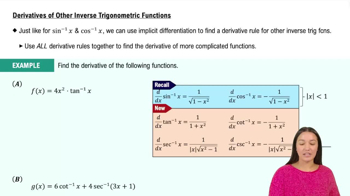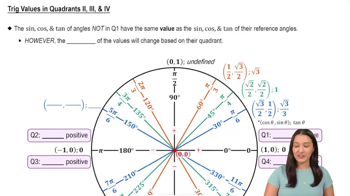Evaluating inverse trigonometric functions Without using a calculator, evaluate the following expressions.
Table of contents
- 0. Functions7h 54m
- Introduction to Functions16m
- Piecewise Functions10m
- Properties of Functions9m
- Common Functions1h 8m
- Transformations5m
- Combining Functions27m
- Exponent rules32m
- Exponential Functions28m
- Logarithmic Functions24m
- Properties of Logarithms36m
- Exponential & Logarithmic Equations35m
- Introduction to Trigonometric Functions38m
- Graphs of Trigonometric Functions44m
- Trigonometric Identities47m
- Inverse Trigonometric Functions48m
- 1. Limits and Continuity2h 2m
- 2. Intro to Derivatives1h 33m
- 3. Techniques of Differentiation3h 18m
- 4. Applications of Derivatives2h 38m
- 5. Graphical Applications of Derivatives6h 2m
- 6. Derivatives of Inverse, Exponential, & Logarithmic Functions2h 37m
- 7. Antiderivatives & Indefinite Integrals1h 26m
- 8. Definite Integrals4h 44m
- 9. Graphical Applications of Integrals2h 27m
- 10. Physics Applications of Integrals 3h 16m
- 11. Integrals of Inverse, Exponential, & Logarithmic Functions2h 31m
- 12. Techniques of Integration7h 41m
- 13. Intro to Differential Equations2h 55m
- 14. Sequences & Series5h 36m
- 15. Power Series2h 19m
- 16. Parametric Equations & Polar Coordinates7h 58m
0. Functions
Inverse Trigonometric Functions
Problem 75
Textbook Question
Evaluating inverse trigonometric functions Without using a calculator, evaluate the following expressions.
tan−13
 Verified step by step guidance
Verified step by step guidance1
Understand that \( \tan^{-1}(x) \) represents the angle whose tangent is \( x \). Therefore, \( \tan^{-1}(\sqrt{3}) \) is the angle whose tangent is \( \sqrt{3} \).
Recall the special angles and their tangent values. The tangent of \( \frac{\pi}{3} \) (or 60 degrees) is \( \sqrt{3} \).
Since \( \tan^{-1}(\sqrt{3}) \) is asking for the angle whose tangent is \( \sqrt{3} \), and we know that \( \tan(\frac{\pi}{3}) = \sqrt{3} \), the angle is \( \frac{\pi}{3} \).
Verify that \( \frac{\pi}{3} \) is within the range of the inverse tangent function, which is \( \left(-\frac{\pi}{2}, \frac{\pi}{2}\right) \). Since \( \frac{\pi}{3} \) is within this range, it is a valid solution.
Conclude that \( \tan^{-1}(\sqrt{3}) = \frac{\pi}{3} \).
 Verified video answer for a similar problem:
Verified video answer for a similar problem:This video solution was recommended by our tutors as helpful for the problem above
Video duration:
3mPlay a video:
Was this helpful?
Key Concepts
Here are the essential concepts you must grasp in order to answer the question correctly.
Inverse Trigonometric Functions
Inverse trigonometric functions, such as an^{-1} (arctan), are used to find the angle whose tangent is a given number. These functions are essential in calculus for solving problems involving angles and their relationships to sides in right triangles. Understanding their ranges and properties is crucial for evaluating expressions without a calculator.
Recommended video:

Derivatives of Other Inverse Trigonometric Functions
Special Angles in Trigonometry
Special angles, such as 30°, 45°, and 60°, have known sine, cosine, and tangent values that are often used in trigonometric evaluations. For example, an(60°) = √3, which directly relates to the expression an^{-1}√3. Familiarity with these angles allows for quick evaluations and simplifications in trigonometric problems.
Recommended video:

Introduction to Trigonometric Functions
Quadrants and Angle Values
The unit circle divides the plane into four quadrants, each corresponding to specific angle values and signs for sine, cosine, and tangent. Knowing which quadrant an angle lies in helps determine the correct value of inverse trigonometric functions. For instance, an^{-1}√3 corresponds to an angle in the first quadrant, where both sine and cosine are positive.
Recommended video:

Trig Values in Quadrants II, III, & IV
Related Videos
Related Practice
Textbook Question


